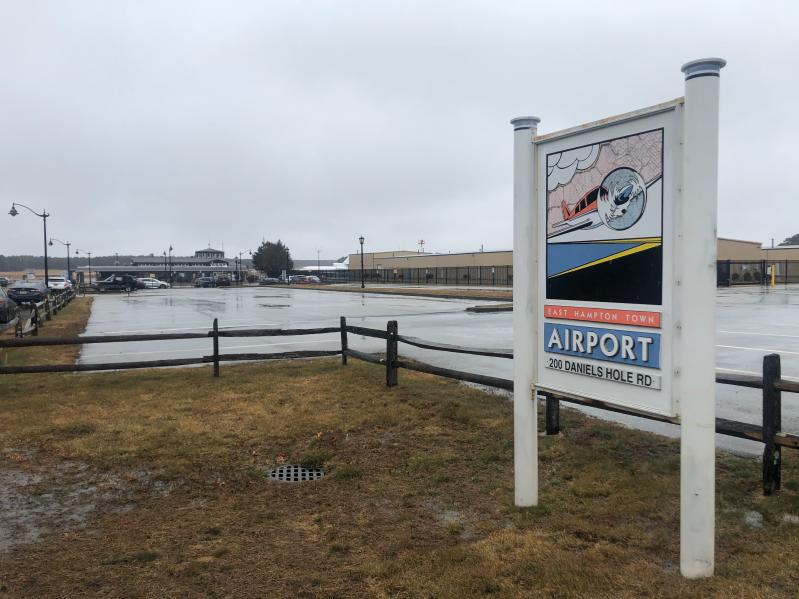The East Hampton Town Board has hit turbulence on its plan to briefly close East Hampton Airport and reopen it four days later as a private-use facility with restrictions on flight activity, after receiving a letter on Feb. 2 from the Federal Aviation Administration warning that "it may take approximately two years to restore the current capability to the airport if it is deactivated" depending on potential environmental analyses.
The board voted unanimously last month to permanently "close" the airport in its current model on Feb. 28 and open it anew as a private-use airport on March 4. When F.A.A. grant assurances expired in September, control of the airport was returned to the town.
The date for the temporary closure was chosen after discussions with the F.A.A. and the conclusion that the brief pause would cause little disruption to aviation. After March 4, the airport would be subject to local control in what the F.A.A. calls a prior-permission-required framework, under which advance clearance is required before a pilot may use the airport. The board has promised to implement substantive restrictions prior to the summer season, after years of complaints from residents of East Hampton and surrounding towns about the airport's impact on quality of life.
At the town board meeting last Thursday Supervisor Peter Van Scoyoc complained that the F.A.A.'s Feb. 2 letter arrived after business hours and had been widely circulated before its delivery to him. In the letter, Marie Kennington-Gardiner, the F.A.A.'s regional administrator, said that at a Jan. 25 meeting with town officials the F.A.A. had emphasized that deactivation of an airport "has genuine consequences." Once an airport is deactivated, "it cannot be reopened with the same facilities and procedures simply by reactivating it," she said.
The agency has a regulatory structure and must maintain safety protocols, and she said these would impact the town's ability to quickly reopen the airport. When the town's deactivation request is processed, Ms. Kennington-Gardiner said, all public instrument procedures will become unavailable and all F.A.A.-operated navigational, weather, and communication aids will be disabled. The existing agreement with New York Terminal Radar Approach Control, known as TRACON, will be terminated, and Class D airspace — the airspace from the surface to 2,500 feet above it — will not be applicable.
When activating the private-use airport, the F.A.A. will conduct an airspace analysis and "must consider the effect of the proposed airport on the safe and efficient use of airspace by aircraft," as well as safety on the ground, "by considering the effect of the proposed airport on existing or contemplated traffic patterns, its effect on the existing airspace structure, and the effects that existing or proposed manmade or natural objects would have on the airport proposal."
Even though the "new" airport would open on the same site with the same facilities as the deactivated airport, the F.A.A. "has not analyzed this airspace in many years," Ms. Kennington-Gardiner said. "The analysis must be completed using the most current criteria in effect, and F.A.A. cannot predict what issues, if any, may arise with either visual flight rule (V.F.R.) or instrument flight rule operations."
Private airports cannot use publicly funded procedures, she continued, and their special-use procedures would have to be developed "if the town wants to replace the canceled public use instrument flight procedures." The town would have to pay for development of those procedures, either by hiring a third party to design them or by entering into a reimbursable development agreement with the F.A.A.
The F.A.A. will also investigate whether the public-use procedures can be replicated as special-use procedures, which would need to meet current criteria and may require amendment. "In that case, the procedures would be considered new procedures," she said. "If the path of the new procedure is altered in any way, a detailed environmental analysis will be required."
Navigational, weather, and communication aids would have to be re-established. "The town could procure the equipment but would have to enter into a reimbursable agreement with F.A.A. to install, certify, and maintain that equipment."
At the board's meeting last Thursday, accusations were flying like helicopters on a Friday afternoon in August. Mr. Van Scoyoc called the F.A.A. disingenuous "to suggest that an extensive evaluation of whether the airport is safe to operate is required." The airport is operating safely now, as it has for decades, he said. "Moreover, if forced to do so, the town can maintain a visual-flight-rule-only, uncontrolled airport if the F.A.A. will not timely approve the tower or procedures."
In a long statement at the start of the meeting, he said that the town will not continue a public-use airport "as it is not consistent with the community's needs." The town has tried to work with the F.A.A. "to establish reasonable limits" at the airport, but neither the F.A.A. nor airport users have been helpful. The town board "undertook a robust process to inform decisions regarding the airport after the expiration of the grant assurances. That is where the town finds itself today."
"Excessive overflight traffic, constant noise, and safety issues are not tolerable in East Hampton," Mr. Van Scoyoc said.
He was "dismayed and frankly floored to read that the F.A.A. stated in writing that East Hampton Airport may not be operating in a safe manner." As it is required to do, the town has relied on F.A.A. oversight for decades, he said.
"There has never been a suggestion from the F.A.A. that East Hampton Airport was unsafe, that the airspace is unsafe, that the procedures are unsafe, or that the town's privately contracted air control tower is unsafe."
The town does not intend to rely on the F.A.A. or New York TRACON to implement and enforce its prior-permission-required restrictions, the supervisor said. "All of this will be handled by the town." The F.A.A.'s letter does not say that a new, private-use airport will not be available on March 4, he noted, and the board is confident that it will open on that date. "The town believes that all of the issues raised by the F.A.A. can be easily addressed by the F.A.A. if it chooses. Any delay by the F.A.A. will be self-inflicted and unnecessary."
"To the extent the airport is not authorized to open or any of its capabilities not improved," he said, "that is the direct result of the F.A.A. turning its back on the town and deciding at the 11th hour that it cannot accomplish what it previously told the town was possible."
His remarks did not preclude a torrent of criticism from callers to the virtual meeting, none more strident than that of Kathryn Slye of the East Hampton Aviation Association. Mr. Van Scoyoc, she said, was attempting "to gaslight the F.A.A. by trying to horribly contort their letter." To frame the F.A.A.'s letter as a safety issue, she said, was "made up out of whole cloth to distract from the fact that callers like me" and others have told the board "that you did not have a plan in place. . . . You ignored and disregarded everything everybody has told you."
"Honestly, how dare you now try to gaslight the rest of this community by telling us we don't know what you're doing," Ms. Slye said, accusing Mr. Van Scoyoc of privately planning to permanently close the airport, "using the F.A.A. as a scapegoat" to conceal the scheme.
Mel Immergut of Sagaponack, a former chairman of the international law firm Milbank, Tweed, Hadley, & McCloy, said that were he to advise the board, he would implore it to "think about your position here" because in the event of "a mishap" at the airport, "you will all be sued personally, in light of this letter from the F.A.A." Until the board has F.A.A. approval on all the issues raised in its letter, "you're all running a serious personal liability issue" if there is a crash or other incident at the airport. He advised them to consult their personal lawyers.
Were he advising those who want the airport permanently closed, he would propose they "go to court and say it's not safe to reopen in light of all the issues the F.A.A. has raised here." That, he said, would result in a lengthy delay in the airport's reopening.
Considering the F.A.A.'s letter, Mr. Immergut said, the thought that the airport would reopen in the near future "is not realistic."
Prior to last Thursday's meeting, the Eastern Region Helicopter Council also weighed in. "The F.A.A. letter finally clarifies the true reality of closing the East Hampton airport and just some of the damaging unintended consequences," said Loren Riegelhaupt, a spokesman. "Rather than following the flawed advice of paid consultants and going against the wishes of roughly 80 percent of the town and their preference to keep the airport open, we again urge the town board to work with the aviation community to keep the airport open and find alternative solutions. Our door remains open and, as always, we are willing and eager to work with the town to finally resolve these issues and avoid the added burden to our roads, infrastructure, and taxpayer funds."
On Tuesday, Mr. Van Scoyoc said that the plan to close the airport on Feb. 28 and reopen a new airport on March 4 stands. "Just what type of amenities will be offered is still being determined with the F.A.A.," he said.
This story has been updated since it was first published online.




